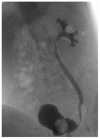Urinary tract infections in the infant
- PMID: 25677994
- PMCID: PMC5511626
- DOI: 10.1016/j.clp.2014.10.003
Urinary tract infections in the infant
Abstract
Urinary tract infection (UTI) in an infant may be the first indication of an underlying renal disorder. Early recognition and initiation of adequate therapy for UTI is important to reduce the risk of long-term renal scarring. Ampicillin and gentamicin are traditionally the empiric treatment of choice; however, local antibiotic resistance patterns should be considered. Maternal antibiotics during pregnancy also increase the risk of resistant pathogens during neonatal UTI. Long-term management after the first UTI in infants remains controversial because of lack of specific studies in this age group and the risk-benefit issues for antibiotic prophylaxis between reduced recurrent disease and emergent antibiotic resistance.
Keywords: Antibiotic resistance; Escherichia coli; Infants; Renal imaging; Urinary tract infection; Vesicoureteral reflux.
Copyright © 2015 Elsevier Inc. All rights reserved.
Figures


References
-
- Shaikh N, Morone NE, Bost JE, et al. Prevalence of urinary tract infection in childhood: a meta-analysis. Pediatr Infect Dis J. 2008;27:302–8. - PubMed
-
- Ismaili K, Lolin K, Damry N, et al. Febrile urinary tract infections in 0- to 3-month-old infants: a prospective follow-up study. J Pediatr. 2011;158:91–4. - PubMed
-
- Zorc JJ, Levine DA, Platt SL, et al. Clinical and demographic factors associated with urinary tract infection in young febrile infants. Pediatrics. 2005;116:644–8. - PubMed
-
- Lin DS, Huang SH, Lin CC, et al. Urinary tract infection in febrile infants younger than eight weeks of Age. Pediatrics. 2000;105:E20. - PubMed
-
- Bonadio W, Maida G. Urinary tract infection in outpatient febrile infants younger than 30 days of age: a 10-year evaluation. Pediatr Infect Dis J. 2014;33:342–4. - PubMed
Publication types
MeSH terms
Substances
Grants and funding
LinkOut - more resources
Full Text Sources
Other Literature Sources
Medical

